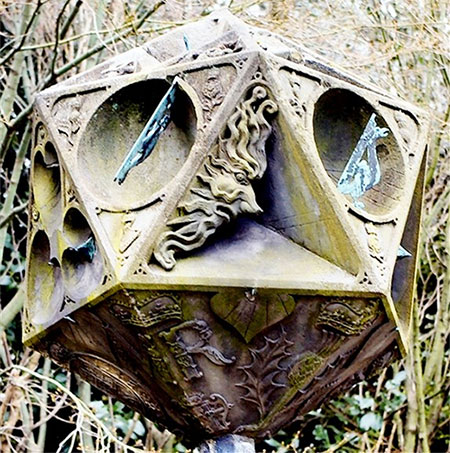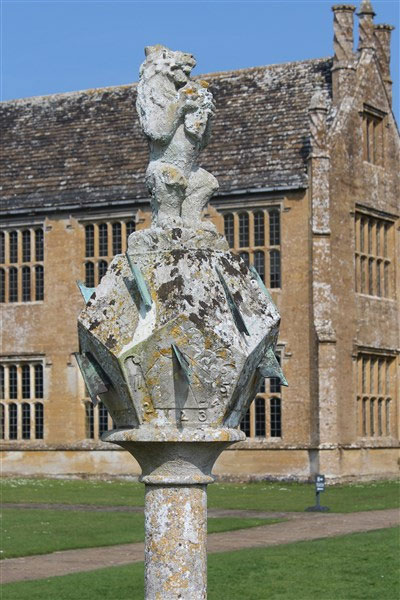Discover the unique sundials of the ancients
Before there were wristwatches or desk clocks, the ancients used the natural method of tracking celestial objects and homemade sundials to tell the time.
The simplest is to take a stick and hammer it into the ground, see where its shadow (when the Sun 'passes', in fact the Earth rotates) to estimate the time to get there.
More complicatedly, a gnomon (needle) is used, which casts a shadow on a graduated stone disc, letting everyone know the moment.

Queen Mary Sundial at Holyrood Palace, Scotland.
From 1500 BC, in Egypt, there was the first sundial, which was a flat limestone rock, carved in the shape of a half-sphere, divided into 12 parts, 15 degrees apart and at the ground corner attached an L-shaped bar to make it it casts shadows every hour.
In addition to that real clock, in the Bible 2,700 years ago, there was also a record of Ahaz's clock indicating sacred moments.
In the first century, people improved the sundial by placing the gnomon parallel to the Earth's axis so that when the Sun moved from East to West, a very clear, precise shadow would appear.
To date, they have made many special watches, not only having one hand but also containing many hands, showing local time, regional time and also universal time. Thanks to erecting monuments that both serve as decorative works and conveniently measure time, sundials, especially multi-faceted, multi-hand watches have appeared everywhere.
The largest sundial to date is the work in the city of Jaipur (India) has been built of stone since 1724, 4 hectares wide with a needle more than 30 meters high.

Barrington Court Clock, Somerset, England.
England, especially Scotland, is home to the largest number of sundials, and most of them are multi-faceted. Mainly built in the 17th-18th centuries, they became the inspiration for inventors to make wristwatches and wristwatches. There are two types of sundial here, including the obelisk tower type and the pulpit type in the lectern cathedral.
At this time, people loved science and math so everyone built a clock. In Scotland, sundials are everywhere, including very tall tower clocks that create a unique beauty.

Lennoxlove Watch, Scotland.

Sundial at Dumfries House, Scotland.
Each is the embodiment of knowledge, success and fortune when attached to the rich life of the nobility. In order to show erudition and well-being, people often do not make single-faced watches, but multi-faceted, multi-needle watches. In particular, the clock in Scotland's Glamis castle has up to 84 hands.
For many Scots, the sundial also signifies integrity and clarity. They often say: 'Live like a sundial, only counting the time of the sun every day'.

Sundial at Groirie, Yvre-l'Eveque, France.

Sundial at Mont Sainte-Odile Abbey, France.
In addition, France and Germany are also two countries with many beautiful sundials, even preserving many ancient sundials from the 15th and 16th centuries. These are polyhedral blocks of gnomon to catch the sun in many places. angle and time, and then reflect on each other, creating many magical shapes.
- Bicycle models on the unique water of the ancients
- Discover unique natural phenomena
- Discover a unique old house hidden in a mountain
- Evidence shows that the ancients knew how to use toothpicks to
- Chilean mummy reveals the disastrous habits of the ancients
- Discover Russia's unique 'unique' rockets once
- Discover unique borders between countries
- The 10 most unique new species discovered in 2010
- Discover 10 unique data centers in the world
- 10 unique things only available in Finland
- Surprising the purpose of the ancients when the soldiers' teeth were killed
- Ancient Chinese summer dresses: More clothes that the ancients bravely wore than their descendants today
 The most famous scientific failures in history
The most famous scientific failures in history Mysterious genius mechanic and the machine froze time
Mysterious genius mechanic and the machine froze time The son carries the 'bad gene' of genius Albert Einstein
The son carries the 'bad gene' of genius Albert Einstein Isaac Newton
Isaac Newton